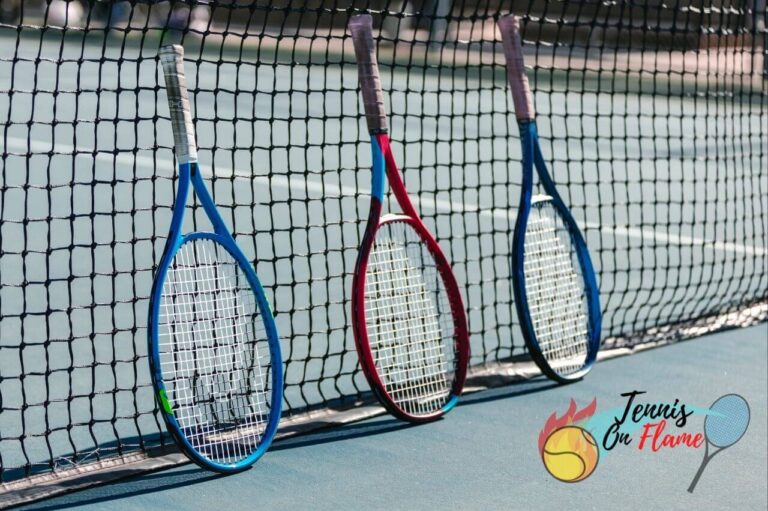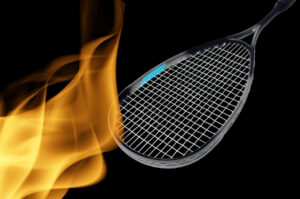Hey there, fellow tennis enthusiasts! If you’re as passionate about the game as I am, you’ve probably wondered about the intricate details that make up the essential tool of our trade – the tennis racket.
Have you ever wondered what materials go into crafting the perfect racket?
Well, wonder no more! In this comprehensive guide, we’ll dissect the various parts of a tennis racket and explore the materials that bring them to life.
Get ready to serve and volley through the fascinating world of tennis racket construction.

The Frame: A Racket’s Backbone
Let’s dive straight into the heart of the matter – the frame. The frame is the foundation of any tennis racket, and its composition plays a pivotal role in determining its performance.
Typically crafted from materials like graphite, titanium, or a combination of both, the frame provides the necessary strength and durability to withstand the rigors of the game.
Advanced materials ensure a perfect balance between power and control, catering to players with diverse playing styles.
In recent years, manufacturers have embraced carbon fiber composites to enhance the frame’s stiffness without adding unnecessary weight. This innovation translates to improved shot accuracy and responsiveness, a real game-changer for players seeking that competitive edge.
Strings: The Harmonious Vibration
Now, let’s shift our focus to the strings – the element that transforms the energy from your swing into the powerful shots we crave. Tennis racket strings come in various materials, the most common being synthetic gut, natural gut, polyester, and multifilament.
Synthetic Gut:
An affordable and versatile option, synthetic gut strings offer a good balance of power and comfort. They are perfect for players looking for a cost-effective solution without compromising performance.
Natural Gut:
Often considered the pinnacle of string materials, natural gut strings made from cow intestines provide exceptional comfort, power, and feel. While they come with a higher price tag, many professional players swear by the unparalleled performance they offer.
Polyester:
Polyester strings, known for their durability and control, are favored by players who generate much power but seek precision in their shots. These strings are excellent for aggressive baseline players who rely on heavy topspin.
Multifilament:
If you’re after the perfect blend of comfort and power, multifilament strings are the way to go. Composed of hundreds of tiny fibers, these strings mimic the feel of a natural gut while being more budget-friendly.
Grip: Finding Your Comfort Zone
Moving on to the grip, this part of the racket connects directly with your hands. The grip is typically made of synthetic materials like polyurethane or leather.
Its primary function is to provide players with a comfortable and secure hold on the racket.
While the standard size of grips may work for many players, finding the grip size that feels just right for you is essential.
An ill-fitting grip can lead to discomfort and even impact your performance on the court.
Experiment with different sizes until you find the one that allows you to play comfortably for extended periods.
Butt Cap: The Finishing Touch
Now, let’s not forget the butt cap, a small but crucial component located at the bottom of the handle.
Usually made of rubber or synthetic materials, the butt cap ensures a comfortable end to the grip while preventing slippage during intense rallies.
It might seem like a minor detail, but a well-designed butt cap contributes to the overall ergonomic feel of the racket.
Handle: Your Connection
The handle is where the magic happens – your connection to the racket. Comprising the grip, pallet, and handle, this section is integral to your playing experience.
Handles are commonly constructed from wood, foam, or synthetic materials.
Modern racket handles often incorporate technology to reduce vibrations and enhance comfort, ensuring a more enjoyable playing experience.
Throat: The Racket’s Vocal Cords
Moving up the racket, we arrive at the throat – the section connecting the handle to the frame.
Typically made of the same materials as the frame, the throat plays a role in the racket’s overall stability and control.
It’s the area where the frame transitions into the head, influencing the racket’s response to your every move.
Head: Powerhouse of Performance
Ah, the head – where power meets precision!
The head is the most recognizable part of the racket, and its size and shape significantly impact a player’s game.
Tennis racket heads come in three main sizes – oversize, midsize, and mid-plus – each catering to different playing styles.
Oversize:
Offering a more prominent sweet spot, oversized heads provide more power and forgiveness. They are ideal for beginners or players looking to minimize mishits.
Midsize:
With a smaller head size, midsize rackets prioritize control over power. Advanced players often prefer this option as it allows for more precise shot placement.
Mid-Plus:
The mid-plus head size balances power and control, making it a popular choice among many players. This versatile option caters to both beginners and seasoned competitors.
Grommets: Protecting Your Strings
Now, let’s talk about grommets – the unsung heroes of racket construction. Grommets are small, often plastic, components that surround the strings’ openings.
Their primary function is to protect the strings from friction and wear against the frame. Advanced rackets may feature technology like string dampeners within the grommets, reducing vibrations and enhancing player comfort.
Dampeners: Silencing the Symphony
Last but not least, we have dampeners – tiny accessories that can significantly impact your playing experience.
Dampeners, often made of rubber or silicone, are inserted between the strings to absorb vibrations and reduce the harsh sound produced upon ball impact.
While not a mandatory addition, many players swear by the comfort and reduced arm strain that dampeners provide.
| Component | Materials |
|---|---|
| Frame | Graphite, Titanium, Carbon Fiber |
| Strings | Synthetic Gut, Natural Gut, Polyester, Multifilament |
| Grip | Polyurethane, Leather |
| Butt Cap | Rubber, Synthetic Materials |
| Handle | Wood, Foam, Synthetic Materials |
| Throat | Graphite, Titanium, Carbon Fiber |
| Head | Oversize, Midsize, Mid-Plus |
| Grommets | Plastic, Advanced Materials |
| Dampeners | Rubber, Silicone |
Conclusion: Crafting Your Perfect Game
And there you have it – a comprehensive exploration of the materials and components that come together to create the perfect tennis racket.
Every part plays a vital role in shaping your playing experience, from the frame to the strings.
So, the next time you step onto the court, you’ll have a deeper appreciation for the craftsmanship behind your racket.
Remember, finding the right racket for your game involves a bit of trial and error.
Experiment with different materials, head sizes, and string types until you discover the combination that complements your playing style.
Armed with this knowledge, you’re on your way to mastering the art of tennis!








